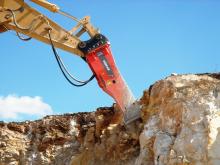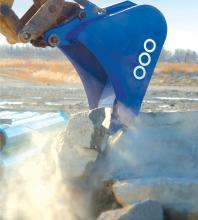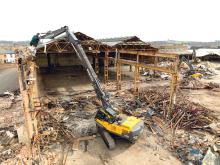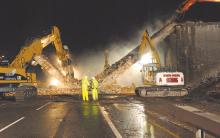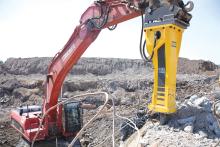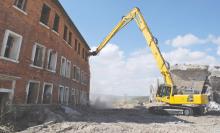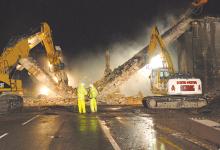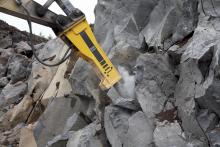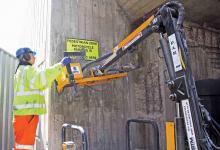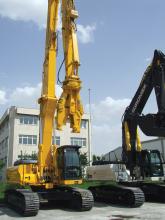Mike Woof reports on equipment developments in the demolition sector. The hydraulic hammer is a tough tool used in a wide array of demolition jobs. Highly versatile, the breaker has evolved from a simple design based on rockdrilling equipment into a sophisticated and reliable piece of machinery. German firm Krupp and French company Montabert were pioneers of the hydraulic breaker, being followed into the market by a growing array of other manufacturers. Early breakers had the unfortunate habit of tearing th
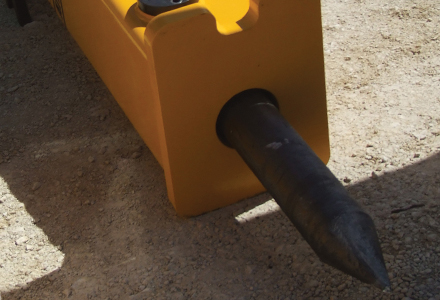
RSS
German firm Krupp and French company2396 Montabert were pioneers of the hydraulic breaker, being followed into the market by a growing array of other manufacturers. Early breakers had the unfortunate habit of tearing themselves apart due to the huge internal forces they generated and they often inflicted serious damage on the carrier because of high levels of transmitted vibration. However technological development has allowed breakers to become bigger, more powerful, more productive and more reliable, while also being longer lived, imposing fewer stresses on the carrier and being quieter in operation. Finding ways of reducing the internal hydraulic forces generated in a hammer caused by blank firing, when the breaker strikes in open air, proved particularly important in extending working life. Lubrication systems for the tool and sophisticated bushings to prevent the ingress of dirt and dust have also played key roles in preventing wear.
In terms of technological development, the European and Japanese manufacturers have tended to lead the field. However there has been steady growth in the numbers of breaker manufacturers in the market which used to be dominated mainly by European and Japanese firms, while all manufacturers have expanded their ranges to include other attachments for demolition, recycling and quarry works. The 1990s saw a rapid increase in South Korean breaker manufacturers and these have been joined more recently by many Chinese companies. The breaker market has become highly competitive and not always in a positive way with some of the larger firms suffering due to smaller companies entering the sector and offering 'will-fit' parts at cut rate prices or in certain instances blatant copies of their hammers. These cheap parts and design copy breakers have tempted many unwary customers looking for a low cost deal, often failing quickly when put to work and with little come back for the owner. The recession has been tough for all manufacturers however, with some firms finding trading conditions too difficult and closing their doors.
With the resurgence in demand for construction and demolition equipment now being seen in many world markets, the hydraulic breaker market is once again responding with new technologies and models to meet demand. Meanwhile other firms have been busy refining existing designs and seeing their units employed on major contracts.
161 Atlas Copco for use in training operators how to use hydraulic breakers correctly. The unit was built in Atlas Copco's Spanish facility and features a simulated cab set inside a chamber that is mounted on hydraulic rams. The rams move the chamber and simulate motion for the trainee sitting at the controls, which are the same as in a standard excavator. Highly sensitive, the simulator responds to the control movements of the operator and enables training to be carried out without risking a piece of equipment or tying up a working machine. The system can be set to simulate the operation and behaviour of various types of breaker in an array of different applications and on both wheeled and crawler excavators. Joanna Canton of Atlas Copco explained, "You can pick the carrier and the tool." The menu list allows a range of four main working applications including quarrying, construction, underground tunnel excavation and underwater breaking. As well as using a hydraulic breaker, when the system is set to a city construction application the user can also select additional attachments such as a cutter, pulveriser and multi-gripper.
At present the firm has built only one of these units as a prototype and it is currently being used for evaluation and training purposes with dealers and customers on request, however it seems likely that the company will opt to build more.
UK manufacturer Arrowhead Rockdrill continues to develop its range of hydraulic breakers with the coming addition of the 12th model to the line-up. The new model is designed for carriers weighing 60tonnes and over, sharing many design features with the existing S series. Prototype testing is underway at present and the new breaker is expected to be ready at the end of 2010 or early in 2011. The new heavy breaker is sound suppressed and has a buffer system to reduce the transmission of shock loads to the carrier and help cut wear and tear. This is a similar feature to the damping system on the next model down in Arrowhead's existing line-up, the 3.3tonne S330. The hydraulic developments will continue at Arrowhead with work on breaker models without tie-bolts and which will be easier to maintain and service, although a launch date has not been set at this stage. In addition Arrowhead is working on a concrete crushing attachment for use in demolition as well as some smaller utility tools for use on compact carriers in the 1 - 9tonne class.
178 Caterpillar is now offering its new S365C and S385C mobile shears for scrap processing and demolition applications, which replace the earlier S365B and the S385B models. These feature bolt-on piercing tips to give protection in critical wear areas, as well as to reduce maintenance in the field without welding, while structural improvements will extend durability.
The bolt-on piercing tip protects the moving jaw on both sides and the tip blades are reversible. The tip can be maintained using conventional hand tools without moving the knives in the jaw and the design maintains positive retention of the piercing blades regardless of opening or closing forces. This design uses identical parts for both sides of the jaw, reducing spare parts inventory and the tip uses dowels to hold the halves in alignment with the jaw and to bear the load when in use. The S365C and S385C shears retain proven features such as fast cycle times, good cutting capabilities along the entire jaw, and 360º. In addition to the bolt-on piercing tips, each of the new shears features bolt-on knife segments running the entire length of the lower jaw, reducing the risk of jamming when cutting thin metals.
For scrap processing, the 7tonne class S365C shear is ideal for boom mounting on the 336DL excavator, and it also can be boom mounted on the 345DL excavator. For demolition work, stick mount the S365C shear on a Cat 365CL or the new 374DL excavator. The 8tonne class shear, the S385C, suits boom mounting on the 345DL excavator, and it also can be boom mounted on the 365CL or 374DL excavator. For demolition work, the S385C shear can be stick-mounted on a 385CL excavator.
325 Sandvik's extensive breaker range is one of the largest in the sector and continues to grow, with new models further broadening the range. The new BR3288 and BR4099 are powerful production hammers for large scale demolition work as well as primary and secondary breaking duties. The customer is offered the choice of casings to suit heavy duty or hard rock applications. The two breakers benefit from a new tie rod system, the V-DAP, that is said to offer extended service life and increased reliability even in hard applications. Product specialist Alan Matchett said, "A major issue on a big breaker is tie rod failure and we just don't get that any more." The BR3288 and BR4099 have been developed from the earlier BR3088 and BR3890 models respectively, which stem from the former G88 and G90 designs of some years ago. The BR3288 suits carriers from 27-40tonnes and offers increased performance over the model being replaced. Designed for carriers weighing 35 - 55tonnes the BR4099 will also be available in tunnelling configuration shortly. Power output has been increased as has reliability and the BR4099 weighs in at 3.5tonnes instead of 3.1tonnes for the earlier BR3890 and Matchett said, "It's just a little bit bigger and heavier." The BR111, BR222 and BR333 models are simple and lightweight breakers aimed at use in the rental sector and utility applications on compact carriers weighing from 0.8 - 4tonnes such as mini excavators and skid steer loaders. The three BR models are offered as alternatives to more sophisticated units in the range and these new hammers are designed to reduce maintenance needs with an integrated upper and lower bushing system and a conventional nitrogen accumulator. Matchett said, "You can very easily take the tool out." Meanwhile Sandvik is also offering its Basic line of breakers to the global market. There are three Basic models available although only one, the BA2323, is being offered in Europe at present and the firm is aiming these simpler and more robust units at the Asian market in particular.
237 Indeco has seen its hydraulic hammers used in some tough working applications in recent times, with breakers operating in busy urban environments and also in sensitive airport sites. In Australia a contractor has been using Indeco breakers to help upgrade Melbourne's Tullamarine airport. Armstrong Construction bought a new HP12000 in addition to its existing HP9000s for breaking up aircraft parking areas at the airport while another firm, G&M Aldridge, used an Indeco IFP1250 pulveriser to help demolish old buildings at the site. In an airport environment dust suppression is a key issue as this can be damaging to costly aircraft engines and this has been used by the contractors involved. At the same time, the high quality concrete used in airport construction is tough on working equipment and can be highly abrasive for demolition tools such as breakers and pulverisers. The sophisticated bushing design in the Indeco breakers for example stops dust from entering the hammer and causing internal problems while at the same time, tool greasing systems prevent wear at the crucial tool and bushing interface.
Underwater use of hydraulic breakers present other technical challenges, with units requiring to be configured specially for this type of application. In Italy a2689 Promove XP4500 hydraulic hammer has been used to break granite underwater as part of a project to restyle the port of Poltu Quatu on Sardinia. Contractor P Aul Immobiliare has carried out the work which involved using blasting to break up 40 concrete blocks weighing 56tonnes each as well as the demolition of underwater granite to deepen the ground and position new pillars for the new structure. The Promove XP4500 breaker, mounted on a Fiat-2200 Kobelco EX455 excavator positioned on a pontoon, was used to break up the underwater granite and demolish concrete. The material was processed using a Promove CP1510 multi-processing crusher fitted to a CAT 319D excavator, then recycled and re-used on site.
Once material is broken up on-site, having equipment available to process this in-situ can provide major cost savings for a contractor. Italian firm MB Crusher has specialised in this field with its crusher buckets, which can be attached to an excavator and used to crush, size and sort broken up concrete that has been removed using a breaker. For the contractor this approach offers considerable gains as the same carrier used for breaking can then be fitted with the crusher bucket to carry out the processing role and this allows an efficient use of site equipment. On-site processing allows a contractor to benefit from reduced costs for material disposal, transport and supply. The resulting material can be re-used for other jobs at the same worksite or be taken elsewhere and used to build road embankments, drainage systems or as fill, in excavation jobs for example.
RSS
Mike Woof reports on equipment developments in the demolition sector
The hydraulic hammer is a tough tool used in a wide array of demolition jobs. Highly versatile, the breaker has evolved from a simple design based on rockdrilling equipment into a sophisticated and reliable piece of machinery.German firm Krupp and French company
In terms of technological development, the European and Japanese manufacturers have tended to lead the field. However there has been steady growth in the numbers of breaker manufacturers in the market which used to be dominated mainly by European and Japanese firms, while all manufacturers have expanded their ranges to include other attachments for demolition, recycling and quarry works. The 1990s saw a rapid increase in South Korean breaker manufacturers and these have been joined more recently by many Chinese companies. The breaker market has become highly competitive and not always in a positive way with some of the larger firms suffering due to smaller companies entering the sector and offering 'will-fit' parts at cut rate prices or in certain instances blatant copies of their hammers. These cheap parts and design copy breakers have tempted many unwary customers looking for a low cost deal, often failing quickly when put to work and with little come back for the owner. The recession has been tough for all manufacturers however, with some firms finding trading conditions too difficult and closing their doors.
With the resurgence in demand for construction and demolition equipment now being seen in many world markets, the hydraulic breaker market is once again responding with new technologies and models to meet demand. Meanwhile other firms have been busy refining existing designs and seeing their units employed on major contracts.
New iron
An innovative breaker simulator system has been developed byAt present the firm has built only one of these units as a prototype and it is currently being used for evaluation and training purposes with dealers and customers on request, however it seems likely that the company will opt to build more.
UK manufacturer Arrowhead Rockdrill continues to develop its range of hydraulic breakers with the coming addition of the 12th model to the line-up. The new model is designed for carriers weighing 60tonnes and over, sharing many design features with the existing S series. Prototype testing is underway at present and the new breaker is expected to be ready at the end of 2010 or early in 2011. The new heavy breaker is sound suppressed and has a buffer system to reduce the transmission of shock loads to the carrier and help cut wear and tear. This is a similar feature to the damping system on the next model down in Arrowhead's existing line-up, the 3.3tonne S330. The hydraulic developments will continue at Arrowhead with work on breaker models without tie-bolts and which will be easier to maintain and service, although a launch date has not been set at this stage. In addition Arrowhead is working on a concrete crushing attachment for use in demolition as well as some smaller utility tools for use on compact carriers in the 1 - 9tonne class.
The bolt-on piercing tip protects the moving jaw on both sides and the tip blades are reversible. The tip can be maintained using conventional hand tools without moving the knives in the jaw and the design maintains positive retention of the piercing blades regardless of opening or closing forces. This design uses identical parts for both sides of the jaw, reducing spare parts inventory and the tip uses dowels to hold the halves in alignment with the jaw and to bear the load when in use. The S365C and S385C shears retain proven features such as fast cycle times, good cutting capabilities along the entire jaw, and 360º. In addition to the bolt-on piercing tips, each of the new shears features bolt-on knife segments running the entire length of the lower jaw, reducing the risk of jamming when cutting thin metals.
For scrap processing, the 7tonne class S365C shear is ideal for boom mounting on the 336DL excavator, and it also can be boom mounted on the 345DL excavator. For demolition work, stick mount the S365C shear on a Cat 365CL or the new 374DL excavator. The 8tonne class shear, the S385C, suits boom mounting on the 345DL excavator, and it also can be boom mounted on the 365CL or 374DL excavator. For demolition work, the S385C shear can be stick-mounted on a 385CL excavator.
In the field
The more recent generations of hydraulic breakers from leading manufacturers offer considerable gains in performance over earlier units. Italian firmUnderwater use of hydraulic breakers present other technical challenges, with units requiring to be configured specially for this type of application. In Italy a
Once material is broken up on-site, having equipment available to process this in-situ can provide major cost savings for a contractor. Italian firm MB Crusher has specialised in this field with its crusher buckets, which can be attached to an excavator and used to crush, size and sort broken up concrete that has been removed using a breaker. For the contractor this approach offers considerable gains as the same carrier used for breaking can then be fitted with the crusher bucket to carry out the processing role and this allows an efficient use of site equipment. On-site processing allows a contractor to benefit from reduced costs for material disposal, transport and supply. The resulting material can be re-used for other jobs at the same worksite or be taken elsewhere and used to build road embankments, drainage systems or as fill, in excavation jobs for example.
RSS

